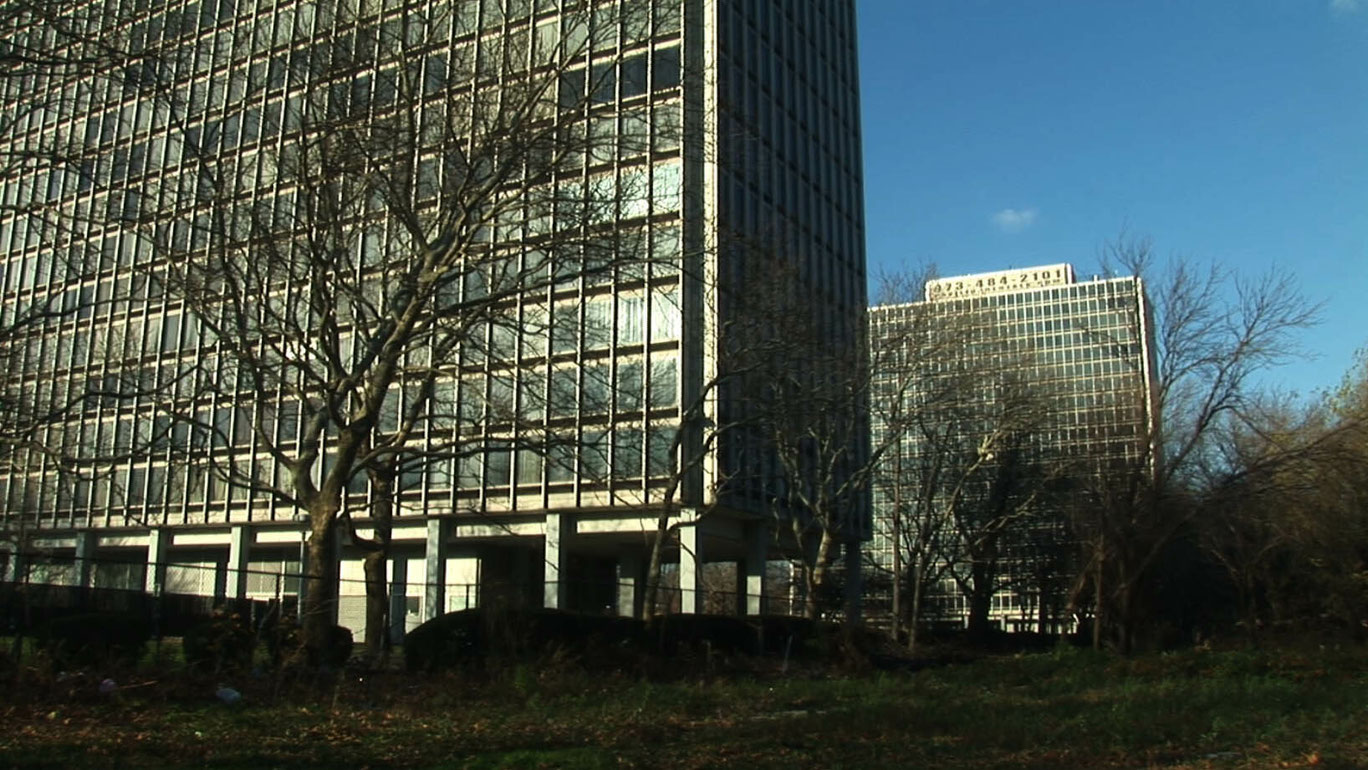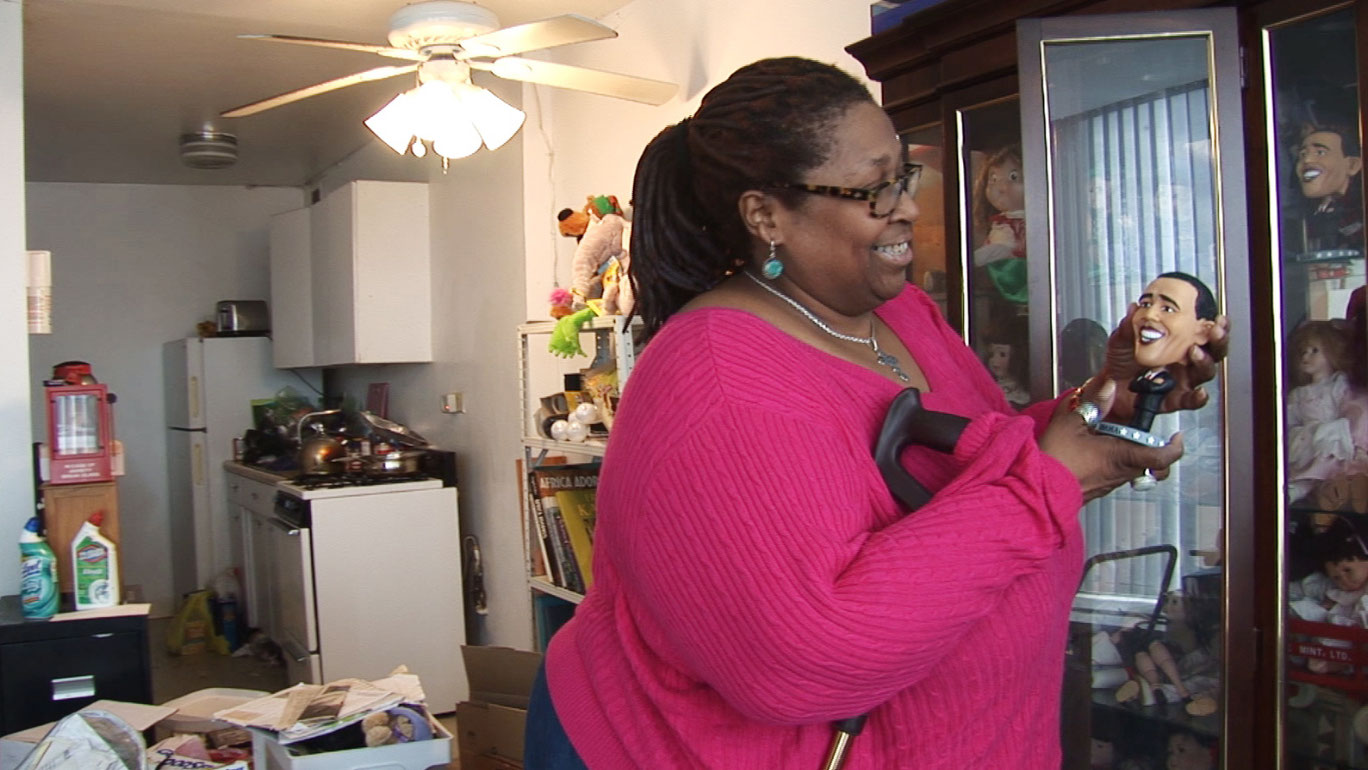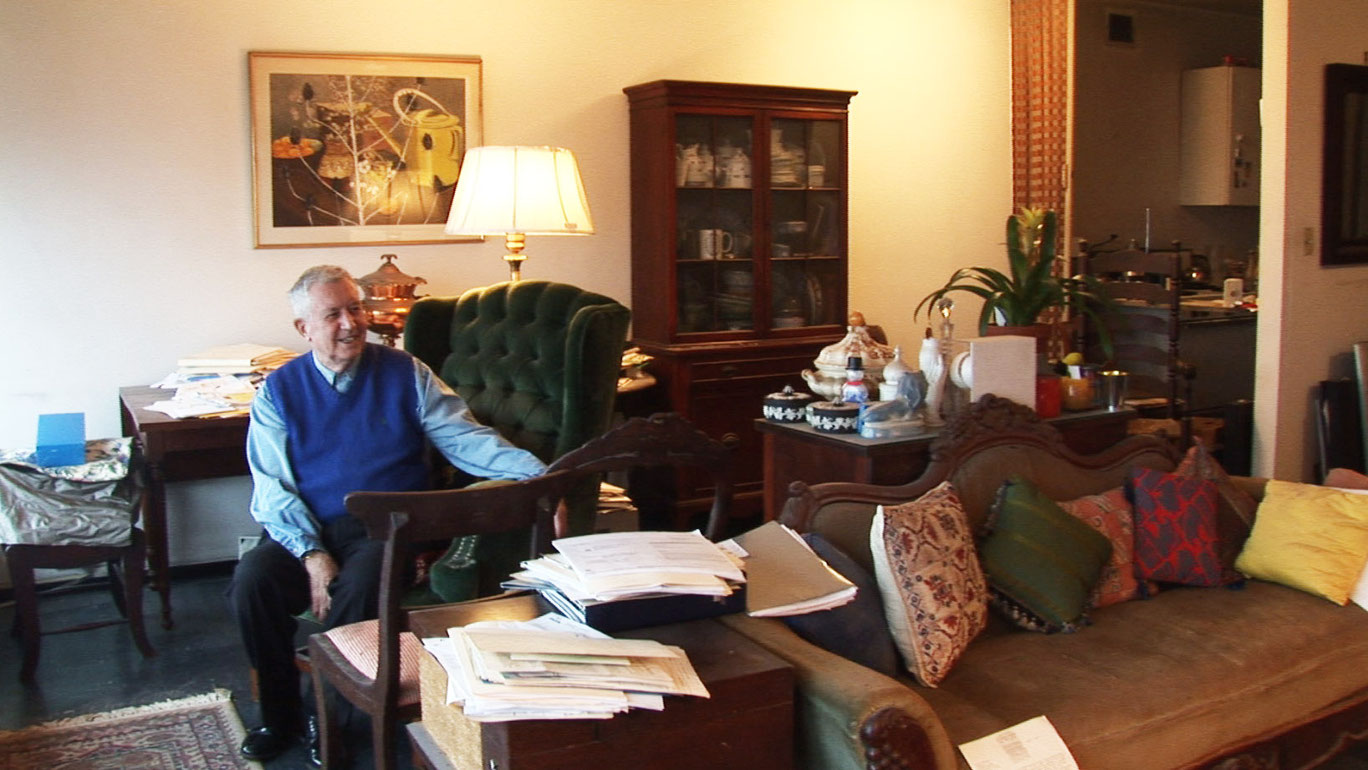Colonnade Park
Die Tragfähigkeit eines Hauses wird in seiner Anwendung deutlich. Mit Colonnade Park, dem letzten Teil einer dokumentarischen Trilogie über modernistische Wohnarchitekturen, wendet sich Heidrun Holzfeind nach Rom (Corviale, Il Serpentone, 2001) und Warschau (Behind the Iron Gate, 2009) erstmals der neuen Welt zu: dem Hochhaus Colonnade sowie zweier Pavilion-Gebäude von Mies van der Rohe in Newark, New Jersey. In den 1950er-Jahren gebaut, um einer mittelständischen Elite das Leben im Zentrum von Newark wieder schmackhaft zu machen, hat das Gebäude eine bewegte Geschichte hinter sich, die über urbane Entwicklungen hinaus auch von gesellschaftlichen Verwerfungen erzählt. Holzfeind bringt auf dem direkten Weg ein eindrückliches Ergebnis hervor. Noch mehr als in den Filmen davor ist es hier das Haus, das die Struktur vorgibt – gleich einem Setzkasten, der mit Porträts von gegenwärtigen Bewohnerinnen und Bewohnern der Häuser gefüllt wird.
Das utopische Projekt des Colonnade Park misst der Film am Erfahrungshorizont eines persönlichen Alltags und seiner Umgebung, in dem die eigensinnige Aneignung und Umgestaltung des Raums sichtbar wird. Nicht wenige der Bewohner legen beispielsweise eine ungewöhnliche Sammlerleidenschaft an den Tag, mit dem Ergebnis, dass das funktionale Äußere des Hauses im Inneren mit einer fast musealen Landschaft individueller Besonderheiten kontrastiert. „Nicht Gesellschaft, sondern Gemeinschaft“ sei das wesentliche Moment des Zusammenlebens hier, meint ein Maler einmal – eine Ansicht, die zumindest für das jeweilige Stockwerk Gültigkeit hat. Insgesamt ist der von auffällig vielen Afroamerikanern sowie Weißen mit Kunstaffinität bevölkerte Wohnbau allerdings dem Modell Gesellschaft näher: ein widersprüchliches Nebeneinander von Identitäten, die vor allem ein spektakulärer Ausblick eint.
(Dominik Kamalzadeh)
Der Film porträtiert das Colonnade und die zwei Pavilion Apartment Gebäude in Newark, New Jersey, die 1954-1960 von Ludwig Mies van der Rohe geplant und gebaut wurden. Die drei Gebäude, ganz im Stil der Lafayette Park Wohnanlage in Detroit, sind 20 Stockwerke hohe Gebäude mit großzügigen EIngangshallen, von den Knien bis zur Decke reichenden Fensterfronten, die im Westen auf den Branch Brook Park ("Newarks Central Park"), im Süden auf Downtown Newark und im Osten auf die Skyline von Manhattan blicken.
(Synopsis)
Colonnade Park (EN)
In the late 1940s, Newark, New Jersey witnessed the mass migration of both manufacturing and the upper classes to the growing suburbs after the industrial boom of the war years. Addressing the expansion of "slums" and the absence of standardized urban housing, the Federal Housing Act of 1949 enabled the clearance of "blighted areas" that would in turn be sold to private developers. These developers in turn approached the cleared sites with the primary objective of constructing middle-income housing. In the case of an Italian-American tenement neighborhood in Newark´s First Ward, the collaboration of private real estate developer Herbert Greenwald and the Newark Housing Authority led to the demolition of 470 structures and the displacement of approximately 4,600 people. The site was soon occupied at its center by the Columbus Homes, eight twelve story, low-income public housing units developed by the city. Targeting middle-income residents, Greenwald invited Ludwig Mies van der Rohe to design three 22-story glass and steel towers—the Pavilion and Colonnade Apartments which came to occupy the borders of the site. When Mies´s buildings were opened to residents in 1960, they embodied a translation of modernist glass and steel construction tailored to a middle-class clientele, accompanied by the prestige of an iconic architect´s signature.
The prioritization of middle class housing development in these years failed to solve what was a housing crisis for the vastly expanding urban poor. Housing shortages and the racial discrimination characterizing admissions policies were chief concerns of both the political demonstrations in Newark in 1967 (dubbed "race riots") and of the continuing momentum of the Black Power movement in the following decade. As the Newark economy stagnated in the 1970s, the Columbus Homes were gradually evacuated, having been subject to arson, vandalism, and neglect. In 1994, the buildings were planted with explosives, to be replaced soon after with the low-rise New Urbanist homes that stand today. In a speech delivered at the demolition, Newark mayor Sharpe James described the destruction of the Columbus Homes as "the end of an American dream that failed." The adjacent middle-class dream (imbued with Mies´s International Style sheen) had also declined dramatically over the course of its first three decades, dubbed by many locals "the glass projects."
In Heidrun Holzfeind´s film, "Colonnade Park", we become acquainted with the current residents of the Colonnade and Pavilion Apartments. The film incorporates Mies´s towers as a structuring framework; the window panes serve to connect the private world of an apartment to the expanse of Newark beyond and around it. Mies´s modernism is here not the primary subject but rather the mise-en-scène for alternate operations—namely, private lives that overflow the standardized shells in which we encounter them. We meet, amongst others, a criminal lawyer, an artist, and a flight attendant. Whereas the lobby maintains the strict restraint of a modernist pavilion—Barcelona chairs and a geometrically printed carpet are the only decor in evidence, the apartments, behind the curtain wall, are idiosyncratic worlds, cascading with myriad collections developed through the years—salvaged industrial objects, African masks, soda bought in bulk. A few tenants have introduced informal systems to the building that produce new community logics — a video lending library, a mail collection service. While some speak of neighborhood crime, one older gentleman shares a brochure marking the buildings´ vernissage in 1959. Amongst Holzfeind´s subjects, nonlinear narratives aggregate, constructing an emergent historical arc through recalled memories (of a residents´ dance club, of riots, of rent strikes) interwoven with other recollections—for instance, a 1980s modeling career evidenced by a scrap book. Just as Holzfeind´s film produces an archive, so too are her subjects archivists.
In conjunction with Colonnade Park, Holzfeind produced photographs documenting the site. During the photo-development process, the lab´s error became Holzfeind´s boon; the prints were delivered streaked and speckled with purplish-blue (sometimes pink) chemical solution. In the resulting images, a whimsical layer is superimposed between the negative (Holzfeind´s composition) and that which it indexes (a corridor, a view from the window, a cathedral in the distance). Between the Colonnade and Pavilion Apartments and these photographs, the spills and splotches displace both the Mies buildings and their 2010 imaging into a hazy third temporality.
Colonnade Park
2011
USA, Österreich
54 min



